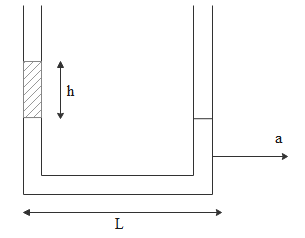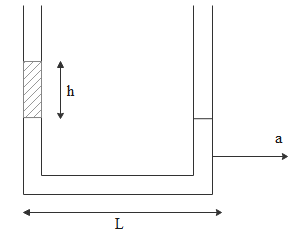
Answer
460.8k+ views
Hint: It is known fact that the liquid has some mass. Now due to that mass there will be weight and pressure acting at every point of the liquid. If the liquid is in static condition then the pressure at points of same height level will be the same for the liquid of same density and different pressures can’t exist for one point. By using this property we will solve this question
Formula used:
$p = \rho {a_{eff}}{x_{eff}}$
Complete answer:
The basic property of any liquid in static condition is it will align its surface perpendicular to the net force. Let us take the example of a liquid in the beaker. The force acting will be its weight and it will be acting vertically downward. Now the surface will be horizontal i.e perpendicular to the net force.
If the surface is not perpendicular then the liquid will be having acceleration along the direction of force and liquid will no longer be in equilibrium.

If we consider the point which is exactly ‘h’ distance down to the top surface of the left limb, the vertical pressure due to gravity will be $p = \rho {a_{eff}}{x_{eff}}$
Along the vertical effective acceleration is acceleration due to gravity i.e ‘g’ and effective ‘x’ is ‘h’
$p = \rho {a_{eff}}{x_{eff}}$
$ \Rightarrow p = \rho gh$
the horizontal pressure due to pseudo acceleration ‘a’ will be $p = \rho {a_{eff}}{x_{eff}}$
Along the horizontal effective acceleration is acceleration due to pseudo force i.e ‘a’ and effective ‘x’ is ‘L’
$p = \rho {a_{eff}}{x_{eff}}$
$ \Rightarrow p = \rho aL$
Since two different pressures can’t exist for the same point of the liquid, equate the horizontal pressure to the vertical pressure. Then we will get
$\eqalign{
& \rho gh = \rho aL \cr
& \Rightarrow h = \dfrac{{aL}}{g} \cr} $
So, the correct answer is “Option D”.
Note:
The resultant force will be the resultant of weight and the pseudo force and the surface of the liquid will be perpendicular to the resultant force vector. We can solve the same problem by assuming liquid is in a beaker and moves with the same acceleration and then also we would get the same answer.
Formula used:
$p = \rho {a_{eff}}{x_{eff}}$
Complete answer:
The basic property of any liquid in static condition is it will align its surface perpendicular to the net force. Let us take the example of a liquid in the beaker. The force acting will be its weight and it will be acting vertically downward. Now the surface will be horizontal i.e perpendicular to the net force.
If the surface is not perpendicular then the liquid will be having acceleration along the direction of force and liquid will no longer be in equilibrium.

If we consider the point which is exactly ‘h’ distance down to the top surface of the left limb, the vertical pressure due to gravity will be $p = \rho {a_{eff}}{x_{eff}}$
Along the vertical effective acceleration is acceleration due to gravity i.e ‘g’ and effective ‘x’ is ‘h’
$p = \rho {a_{eff}}{x_{eff}}$
$ \Rightarrow p = \rho gh$
the horizontal pressure due to pseudo acceleration ‘a’ will be $p = \rho {a_{eff}}{x_{eff}}$
Along the horizontal effective acceleration is acceleration due to pseudo force i.e ‘a’ and effective ‘x’ is ‘L’
$p = \rho {a_{eff}}{x_{eff}}$
$ \Rightarrow p = \rho aL$
Since two different pressures can’t exist for the same point of the liquid, equate the horizontal pressure to the vertical pressure. Then we will get
$\eqalign{
& \rho gh = \rho aL \cr
& \Rightarrow h = \dfrac{{aL}}{g} \cr} $
So, the correct answer is “Option D”.
Note:
The resultant force will be the resultant of weight and the pseudo force and the surface of the liquid will be perpendicular to the resultant force vector. We can solve the same problem by assuming liquid is in a beaker and moves with the same acceleration and then also we would get the same answer.
Recently Updated Pages
Fill in the blanks with suitable prepositions Break class 10 english CBSE

Fill in the blanks with suitable articles Tribune is class 10 english CBSE

Rearrange the following words and phrases to form a class 10 english CBSE

Select the opposite of the given word Permit aGive class 10 english CBSE

Fill in the blank with the most appropriate option class 10 english CBSE

Some places have oneline notices Which option is a class 10 english CBSE

Trending doubts
Fill the blanks with the suitable prepositions 1 The class 9 english CBSE

How do you graph the function fx 4x class 9 maths CBSE

When was Karauli Praja Mandal established 11934 21936 class 10 social science CBSE

Which are the Top 10 Largest Countries of the World?

What is the definite integral of zero a constant b class 12 maths CBSE

Why is steel more elastic than rubber class 11 physics CBSE

Distinguish between the following Ferrous and nonferrous class 9 social science CBSE

The Equation xxx + 2 is Satisfied when x is Equal to Class 10 Maths

Differentiate between homogeneous and heterogeneous class 12 chemistry CBSE





